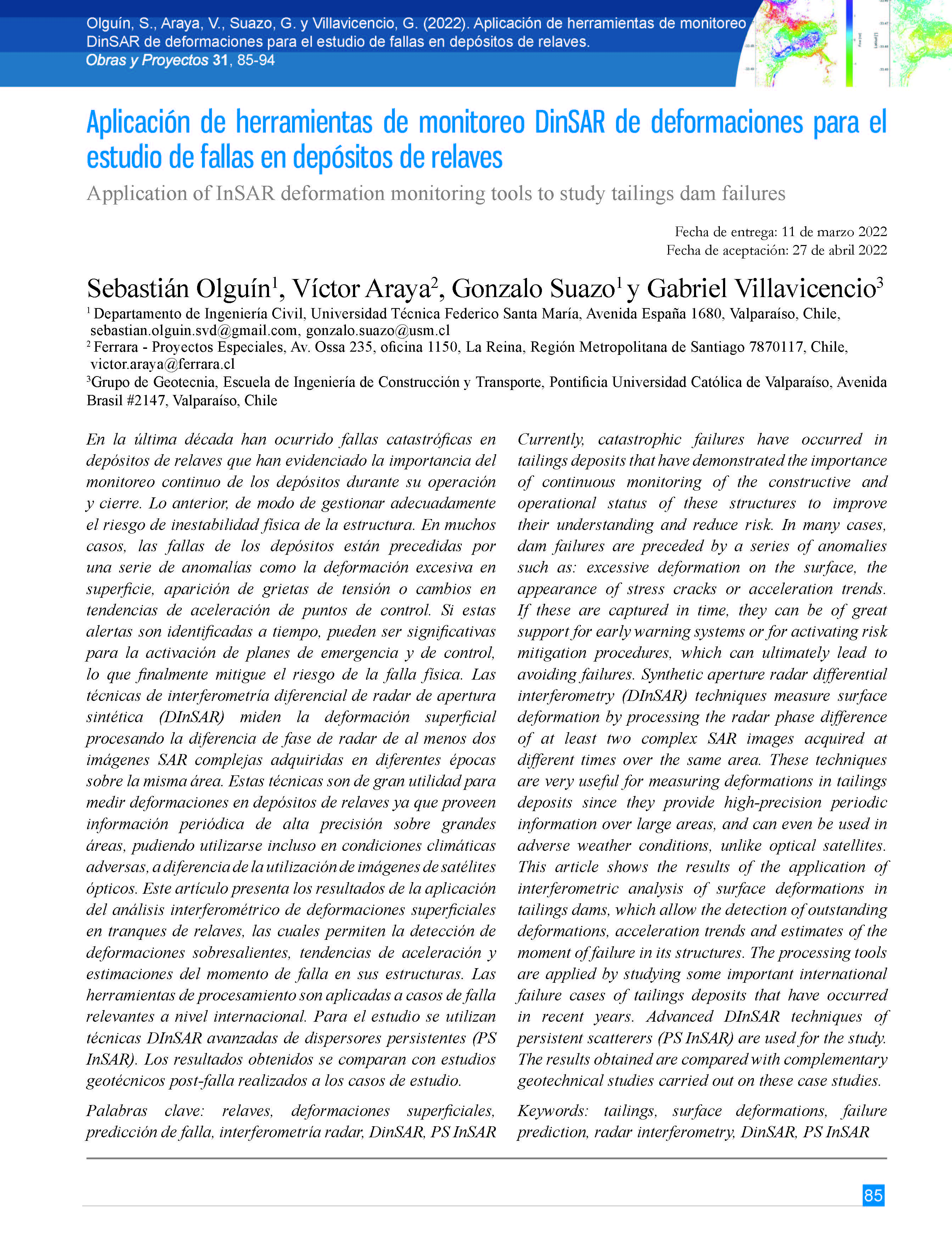Aplicación de herramientas de monitoreo DinSAR de deformaciones para el estudio de fallas en depósitos de relaves
DOI:
https://doi.org/10.4067/S0718-28132022000100085Palabras clave:
Relaves, Deformaciones superficiales, Predicción de falla, Interferometría radar, DinSAR, PS InSARResumen
En la última década han ocurrido fallas catastróficas en depósitos de relaves que han evidenciado la importancia del monitoreo continuo de los depósitos durante su operación y cierre. Lo anterior, de modo de gestionar adecuadamente el riesgo de inestabilidad física de la estructura. En muchos casos, las fallas de los depósitos están precedidas por una serie de anomalías como la deformación excesiva en superficie, aparición de grietas de tensión o cambios en tendencias de aceleración de puntos de control. Si estas alertas son identificadas a tiempo, pueden ser significativas para la activación de planes de emergencia y de control, lo que finalmente mitigue el riesgo de la falla física. Las técnicas de interferometría diferencial de radar de apertura sintética (DInSAR) miden la deformación superficial procesando la diferencia de fase de radar de al menos dos imágenes SAR complejas adquiridas en diferentes épocas sobre la misma área. Estas técnicas son de gran utilidad para medir deformaciones en depósitos de relaves ya que proveen información periódica de alta precisión sobre grandes áreas, pudiendo utilizarse incluso en condiciones climáticas adversas, a diferencia de la utilización de imágenes de satélites ópticos. Este artículo presenta los resultados de la aplicación del análisis interferométrico de deformaciones superficiales en tranques de relaves, las cuales permiten la detección de deformaciones sobresalientes, tendencias de aceleración y estimaciones del momento de falla en sus estructuras. Las herramientas de procesamiento son aplicadas a casos de falla relevantes a nivel internacional. Para el estudio se utilizan técnicas DInSAR avanzadas de dispersores persistentes (PS InSAR). Los resultados obtenidos se comparan con estudios geotécnicos post-falla realizados a los casos de estudio.
Referencias
Bowker, L.N. and Chambers, D. (2015). The risk, public liability and economics of tailings storage facility failures. http://www.csp2.org/files/reports/Bowker
Carlà, T., Intrieri, E., Di Traglia, F., Nolesini, T. Gigli, G. and Casagli, N. (2017). Guidelines on the use of inverse velocity method as a tool for setting alarm thresholds and forecasting landslides and structure collapses. Landslides 14(2), 517-534.
Crosetto, M., Crippa, B., Biescas, E., Monserrat, O. and Agudo, M. (2005). State-of-the-art of land deformation monitoring using differential SAR Interferometry. ISPRS Workshop 2005: High-Resolution Earth Imaging for Geospatial Information. Hannover, Germany.
Dick, G.J., Eberhardt, E., Cabrejo-Liévano, A.G., Stead, D. and Rose, N.D. (2014). Development of an early-warning time-offailure analysis methodology for open-pit mine slopes utilizing ground-based slope stability radar monitoring data. Canadian Geotechnical Journal 52(4), 515-529.
Ferretti, A., Prati, C. and Rocca, F. (2001). Permanent scatterers in SAR Interferometry. IEEE Transactions on Geoscience and Remote Sensing 39(1), 8-20.
Fukuzono, T. (1985). A new method for predicting the failure time of a slope. 4th International Conference and Field Workshop on Landslides, Tokyo, Japan, 145-150.
Hooper, A., Zebker, H., Segall, P. and Kampes, B. (2004). A new method for measuring deformation on Volcanoes and other natural terrains using InSAR Persistent Scatterers. Geophyiscal Research Letters 31, 1-5.
Morgenstern, N., Jefferies, M., Van Zyl, D. and Wates, J. (2019). Report on NTSF Embankment Failure. Ashurst Australia, Independent Technical Review Board.
Morgenstern, N., Vick, S., Viotti, C. and Watts, B. (2016). Report on the immediate causes of the failure of the Fundão Dam. Cleary Gottlieb Steen & Hamilton LLP, Fundão Tailings Dam Review Panel.
Mudd, G. (2007). Global trends in gold mining: Towards quantifying environmental and resource sustainability? Resources Policy 32(1-2), 42-56.
Petley, D.N., Bulmer, M.H. and Murphy, W. (2002). Patterns of movement in rotational and translational landslides. Geology 30(8), 719-722.
Robertson, P., de Melo, L., Williams, D. and Wilson, W. (2019). Report of the expert panel on the technical causes of the failure of Feijão Dam I. Vale, Expert Panel.
Roche, C., Thygesen, K. and Baker, E. (2017). Mine tailings storage: Safety is no accident. A UNEP Rapid Response Assessment. Nairobi and Arendal: United Nations Environment Programme and GRID-Arendal.
Sánchez, C., Del Conte, S. and Verdugo, M.Á. (2019). Operational InSAR monitoring for tailings dams. Tailings 2019: 6th International Seminar on Tailings Management. Santiago, Chile.
Vanden Berghe, J.-F., Ballard, J.-C., Wintgens, J.-F. and List, B. (2011). Geotechnical risks related to tailings dam operations. Tailings and Mine Waste Conference. University of British Columbia Library, Vancouver, Canada.
Voight, B. (1989). A relation to describe rate-dependent material failure. Science 243, 200-203.

Descargas
Publicado
Número
Sección
Licencia

Esta obra está bajo una licencia internacional Creative Commons Atribución-NoComercial 4.0.







